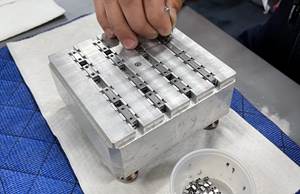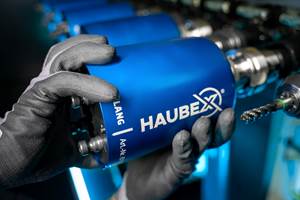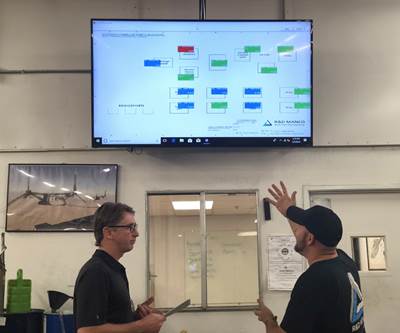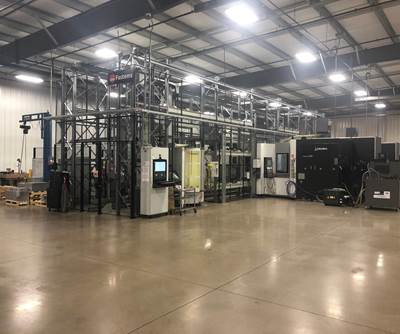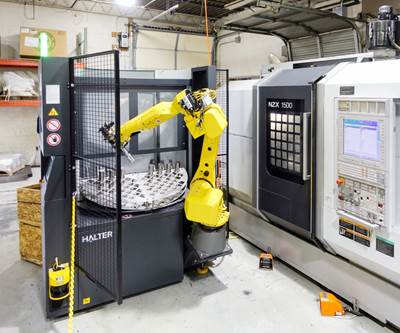
Two years ago, Mike Budde purchased Toolrite Manufacturing, a tooling and detail shop. His goal is to expand the shop, which is now called Budde Precision Machining, to also take on aerospace and medical production work.
Two years ago, Mike Budde purchased Toolrite Manufacturing, a tool and detail shop in Dayton, Ohio. It was a successful company, but Budde wanted to build off of its tooling base and expand capacity to take on part-production work, particularly in lucrative sectors including medical, defense and aerospace.
But why combine tooling with aerospace, defense and medical production? Budde sees tooling work as a good foundation for a production manufacturer. “When you have a tooling department that’s flexing its muscles for external customers, it’ll be able to support an internal customer successfully,” he explains. The diverse nature of tooling work provides a wide range of skills and experience that will be an asset when engineering processes for complex, automated, high-production jobs.
“When you have a tooling department that’s flexing its muscles for external customers, it’ll be able to support an internal customer successfully.”
With Toolrite Manufacturing serving as a solid foundation in this way, Budde had to devise a business plan to build toward his goal: a manufacturer that excels at both tooling and production work. But the company, which is now called Budde Precision Machining, faces limitations. It is still cash-strapped from the acquisition. The new owner therefore had to figure how to start growing the business into these new markets without major capital expenditures, and without taking resources away from the tooling work that was the shop’s legacy and main source of profit. As he put it, he didn’t want to get ahead of himself.
As baby boomer shop owners reach retirement and a new generation of owners takes over, many shops and many leaders of these shops will find themselves in similar situations. A new owner might have a different vision for the company. If so, these new owners must figure out a plan that balances maintaining the shop’s strength and value, balancing what works in the short term with long-term goals.
When we spoke with Budde, the shop was working on a prototyping job. This particular job, which is for the defense industry, involves machining 200 pieces of five different part numbers. It’s higher volume than the tooling jobs the shop traditionally took, but it’s not fully production work either. However, the shop is treating it like it’s a production job. This is a key to Budde’s plan — taking prototyping work in the markets he’s targeting with the hope of converting it to production work.
In preparation for this work, Budde has made a few changes within the company. First, the shop needed proper process controls to handle the requirements of production work, and in particular, work in the medical, aerospace and defense industries. Then Budde developed a sales strategy to target this new work. And finally, the shop invested in unattended machining to expand its capacity, allowing it to handle prototyping and production jobs on top of tooling.
Process Control

Before Mike Budde became the president and owner of Budde Precision Machining, he worked in different roles, including quality, machining and front office, at manufacturers producing parts for the automotive, medical and defense industries.
“Process control, for us, it has a lot of layers to it,” Budde says. At one level, it refers to the quality systems the shop put in place. These include AS9100 and ISO 13485 certifications (for aerospace medical devices, respectively), which the shop received in late 2019, as well as ITAR compliance and registration. “That first step allowed us to engage with the customer,” he says.
These certifications required changes to the shop’s quality management systems, but according to Budde, the changes weren’t drastic. “For me coming in, we had some pretty good overall processes on the quality systems side,” he says. Getting these certifications entailed formalizing these processes and putting them on paper.
Although its quality systems didn’t need to change much to accommodate the new work, the shop’s mindset had to change. If machining is a combination of art and science, Budde says, lower-volume work requires more art and production work requires more science. So as the shop takes on production jobs in addition to tooling work, it will have to maintain both mindsets. Budde believes that by using the more scientific approach to quality on its production work, the shop will be able to learn and improve its quality processes for its tooling work as well.
Process control also serves as the basis for other stages of Budde’s plan. “How you go through and choose your inspection plan, and how you choose your fixturing, all of that ties together from an engineering standpoint. And implementing the automation requires a lot of that mindset,” he says. “So in a lot of ways, we were able to achieve the unattended machining because of that level of process control.”
Building Customer Intimacy
In his role as owner and president, Budde took on sales responsibilities for the company. The strategy he has developed emphasizes what he refers to as “customer intimacy.” Taking prototyping work is ideal for building customer intimacy because these jobs are at the point where customers can gather feedback about the part and iterate. Budde says he engages with prototyping customers to discuss design for manufacturability (DFM) and risk mitigation, and to understand what the company’s priorities are. “We’re not just dumping parts over the fence, but really trying to understand what’s needed,” he explains.
The COVID-19 pandemic has posed a challenge to building customer relationships, including the one for the defense prototyping job. “You don’t get that facetime,” Budde explains. “You can’t give a tour.” Despite this, the shop is keeping in touch with the customer via phone, and the two have worked together to make some changes to parts. He says the buyer put the shop in contact with the customer’s engineering department, and together they made a number of revisions to help ensure the part was cost-efficient.
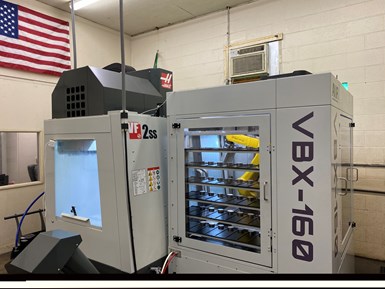
Budde had to devise a plan to shift the shop from tooling to production work without significant capital expenditure and without completely turning its back on tooling work. This VBX-160 automation system from Automation Within Reach is helping the shop increase capacity so it can take on prototyping and production work in addition to tooling jobs.
Automation
The third pillar of Budde’s plan is unattended machining through automation. As the shop takes on prototyping and production work in addition to its regular tooling work, it will need more machining capacity. Lights out machining presents a way for the shop to run higher-volume prototyping and production jobs overnight, and then run tooling and detailing work during the day, when machinists are available to give these jobs the attention they need.
Budde wanted to start implementing unattended machining, but again, he didn’t want to get ahead of himself. He needed to find a system that was flexible enough to handle production jobs, prototyping jobs and even some tooling work.
The shop eventually added a Load & Go VBX-160 robot loading unit outside one of its Haas VF-2SS machining centers. This system, which comes from Automation Within Reach, consists of a FANUC robot arm, a cabinet with shelves where blanks and finished parts are stored, a gripping system and a conversational programming interface. The VBX-160 is designed to be easy to set up and re-deploy for new parts, making it suitable for lower volume jobs as well as high-volume jobs. This gives Budde Precision Machining the flexibility to run both high- and lower-volume work across the system.
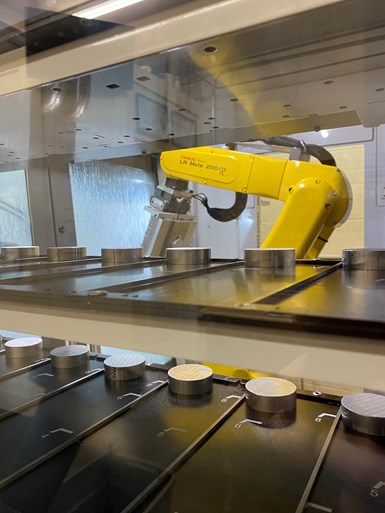
The VBX-160 automation system comes with a FANUC robot arm, a gripping system, a conversational programming interface, and a cabinet with shelves where blanks and finished parts are stored. It’s easy to set up and re-deploy for new parts, making it suitable for both low- and high-volume jobs.
Another point of flexibility is that the system doesn’t require grippers, which often need to be changed when an automation system is reconfigured for a new part. Instead, the robot in the VBX-160 picks up the part using the same vise jaws that hold the part in the machine tool. It loads the base jaws into the machine, and then picks up a blank with the top jaws and loads jaws and part into the machine together. If the part has a second operation, like the prototype job the shop was machining, instead of using a turnover station, the robot flips the part into a second set of jaws on the machining table. Outside the machine, the robot uses the “op. 10” top jaws to grab a blank and transition the part to jaws for op. 20. When op. 20 is complete, the robot places new op. 10 top jaws with blank into the vise, removes the finished part and op. 20 top jaws from the machine, and drops the complete part onto a shelf in the cabinet.
In a non-automated cell, after the operator moved the part to a second set of jaws, he or she would be able to ensure the part is fully seated. Finding a way to assure this in the robotic cells was a challenge, and Budde Precision Machining came up with its own solution. The shop created a push pad and added it to the toolchanger, so after the part is flipped into the op. 20 jaws, the toolchanger loads the push pad and pushes the part down into the jaws.
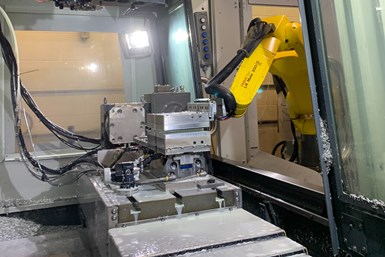
Instead of using grippers, the robot picks up parts using the vise jaws. This also enables the robot to flip a part into another set of jaws without requiring a turnover station.
The shop had to make another adjustment to its machine in order to run the cell lights out. This job requires a small endmill that breaks easily, so the machine was stopping frequently. This presented an obstacle for running lights out, so the company turned to its Haas sales rep for help. The machine tool supplier was able to “hijack” the tool break detect routine, Budde says, so that instead of stopping when the tool broke unexpectedly, the CNC would expire that tool, pull an extra tool from the toolchanger and execute a coded decision on how to keep going. This has helped the shop run the cell unattended for 36-hour stretches, including on weekends.
What’s Next?
When we spoke to Budde, the shop had acquired a handful of production
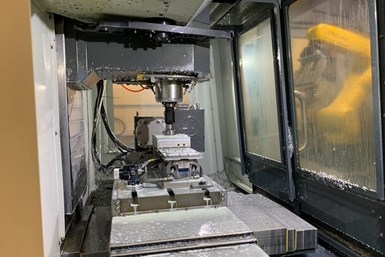
Once the part has been flipped, Budde Precision Machining needed a way to ensure the part was fully clamped into the op. 20 jaws. The shop created a push pad and added it to the toolchanger, so once the part is flipped, the push pad can ensure it’s fully seated.
customers, as well as some prototyping work it hoped would lead to more production. He says the shop’s short-term goal is finding more work to fill the robotic cell, which is currently at 20% capacity.
In the long-term, Budde says the goal is to reduce competition by adding capabilities. The shop recently took a step in this direction by adding a five-axis machining center, which will expand the shop’s capabilities and increase efficiency. Eventually, as the shop gains the ability to take on work with exotic materials and more complex geometries, he says, the shop will become more and more profitable, as it advances into areas where fewer shops have the ability to compete for that work.
Related Content
Niche Work If You Can Get It: A CNC Machine Shop Crafts Its Own Destiny
The latest innovations in metalworking aren’t always related to CNC automation or robotics. For Rosenberger North America, a 2022 Top Shops Honoree, it is the company’s niche processes that create the biggest successes.
Read MoreUsing the Toolchanger to Automate Production
Taking advantage of a feature that’s already on the machine tool, Lang’s Haubex system uses the toolchanger to move and store parts, making it an easy-to-use and cost-effective automation solution.
Read MoreBuilding an Automation Solution From the Ground Up
IMTS 2022 provides visitors the opportunity to meet with product experts to design automation solutions from scratch.
Read MoreCNC Machine Shop Honored for Automation, Machine Monitoring
From cobots to machine monitoring, this Top Shop honoree shows that machining technology is about more than the machine tool.
Read MoreRead Next
Merging Advances: Lights-Out Machining Combines Automation and Focused Process Improvement
One of the most significant developments in machining right now is easy to miss because it is the union of two different advances coming together.
Read MoreTaking an Automated Aerospace Approach
A flexible manufacturing system helps an Indiana job shop run a high mix of aerospace work for long stretches of time and function more like a contract shop.
Read MoreAn Automation System for a Job Shop Environment
A flexible robotic part-loading and unloading system enables a small Indiana shop to boost production without a large investment.
Read More


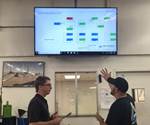

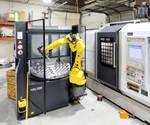








.png;maxWidth=300;quality=90)










